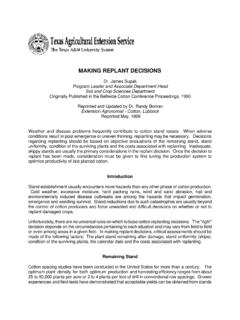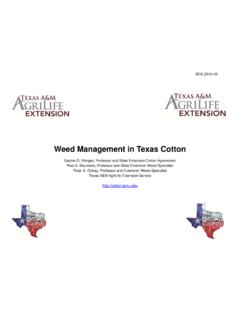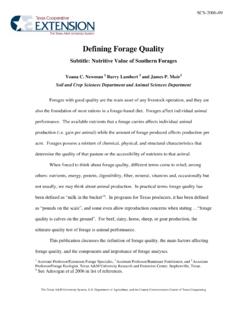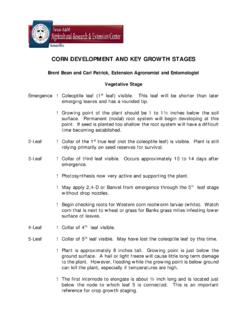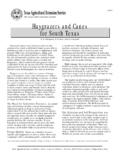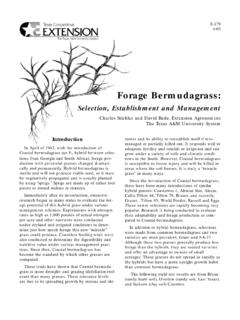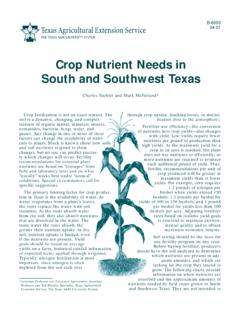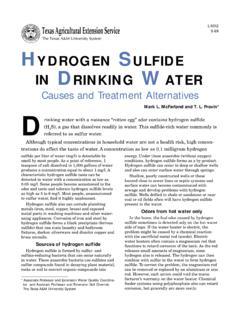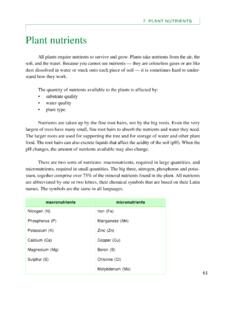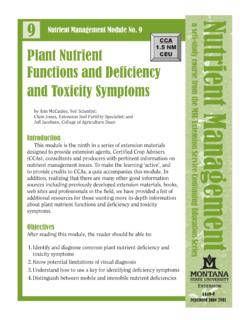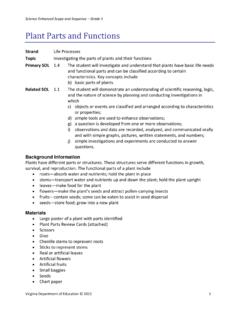Transcription of Using Soluble Calcium to Stimulate Plant Growth
1 Research has shown that applying Soluble calciumwith urea, an ammonium form of nitrogen, canimprove crop production. Calcium increases ammoni-um, potassium and phosphorus absorption, stimulatesphotosynthesis, and increases the size of sellable plantparts. It also makes the use of nitrogen more efficient,which improves the economics of production andreduces nitrogen contamination of the the Research Was ConductedVarious Plant species grown in greenhouses were fer-tilized several times during the growing season withnutrient solutions containing various Calcium -to-ammo-nium ratios, so that the value of increasing the amountof Soluble Calcium could be tested. Check plants weregiven nitrate fertilizer with no increased amounts of sol-uble Calcium . Most field plots were planted in 40-inchrows and most greenhouse tests were accompanied byfield experiments.
2 Greenhouse plants were grown tocertain stages and then harvested. The harvested plantswere weighed and divided into seeds, bulbs, leaves,stems and roots so the parts could be tested for nutrientconcentrations. In the field experiments, the commer-cial products were harvested and the yields of CalciumWhen urea (46-0-0), anhydrous ammonia ( ) or diammonium phosphate (18-36-0) is band-ed into the soil, an equivalent amount of Calcium is precipitated. The Plant roots cannot access nitrogen inan environment containing more than 32 percentammonium. Roots can be killed, but usually they growaround the fertilizer bands. After the soil microbes haveconverted much of the banded ammonium to nitrate,then the roots can begin to use the nitrogen. Whenextra Soluble Calcium is applied with the fertilizer itlowers the pH of the fertilizer band, thus reducing itstoxicity.
3 If Calcium is applied beyond precipitationrequirements, it stimulates ammonium absorption byplants. Adding supplemental Calcium has increased therate at which plants absorb ammonium by as much as100 percent. As some of the ammonium is changed tonitrate, the previously precipitated Calcium is graduallyresolubilized, adding to the available Soluble calciumconcentrations that increase increased ammonium absorption caused by cal-cium has interesting results. Photosynthesis increases(Fig. 1), and greater amounts of carbon dioxide are cap-tured by the Plant from the air, which increases theplant s organic building blocks (Fig. 2). When plantsabsorb more ammonium, less nitrogen remains in thesoil and is subject to leaching. Also, surplus nitrogenabsorbed by plants is stored and is available to promotegrowth all season.
4 In trials, both bermudagrass and rye-grass showed this effect, with denser Growth and color(chlorophyll-photosynthesis) throughout the season (Fig. 3). Perhaps the most beneficial effect of applying calci-um with ammonium is that plants change their normalpattern of depositing energy stores (carbohydrates,metabolites) (Figs. 4, 5). As Figure 4 shows, rice plantshad progressively lower leaf weight and progressivelyhigher grain weight as Calcium levels increased. Thisincrease continued with all Calcium concentrations. Onereport showed that adding Soluble Calcium to ricepaddy water resulted in up to 15 percent of the flagleaf s energy production being transported to the fillingseeds (as opposed to 5 percent without Calcium ). Riceweights increased 14 percent when extra Calcium wasapplied at seed Soluble Calcium to Stimulate Plant GrowthSam E.
5 Feagley and Lloyd B. Fenn**Professor and Extension Soil Environmental Specialist; andProfessor, Texas Agricultural Experiment Station, The Texas A&MUniversity dry weight increase (%)CabbageCantaloupeChileRadishSquashTom atoPlant200 Figure 1. Increased photosynthesis results fromcalcium same observation was made with beets, onions,wheat, oats and barley (Figs. 5, 6). Within 30 hours ofapplication, onion and beet bulbs increased in weightby up to 50 percent over bulbs grown with nitrate(without ammonium). The weight of the entire Plant ,however, did not increase as much as the bulb, whichmeans that Calcium causes the carbonaceous com-pounds to be deposited disproportionately in the bulbs(Fig. 5).Incorporating Calcium into fertilizers has secondarybenefits to crop production as well.
6 In irrigated soils,sodium always builds up and the continuing addition ofcalcium helps improve soil structure near Plant rootzones. In acid soils, where liming is practiced, the solu-ble Calcium chloride will more rapidly migrate to thelower root zone, reducing the toxic effects of ratios of Calcium to ammonium could be justi-fied for this to Use Calcium withNitrogen FertilizersNitrogen can be applied in several ways. It can bebroadcast on the surface of pasture land or prepared(crop) soil and watered in by rain or irrigation. It can bebanded. Or, nitrogen can be applied with irrigationwater, a method that does not Stimulate Plant Growth asmuch as broadcast application. Each producer shouldselect the method that best fits the needs and econom-ics of his production plants1987% increase over urea alone Relative Plant Growth increase (%)20406080 BeetsOnionsRadishesCarrots1988% increase over urea alone Relative Plant Growth increase (%)067892 4 6 8 10 12 14 NH4NO3 Urea+CaCa(NO3)2 CheckColor96 lbs.
7 N/creUreaWeeks after aplication067892 46 810 1214 Weeks after aplicationUrea0 CaUrea, Ca(NO3)2 CheckThatch density (relative scale)NH4NO3BA102030400 100 200 300N Level (ug L-1)Grain and straw weight (g/POT)0400800120012008004000ug L-1 CaStrawRiceFigure 2. Relative yield of vegetables grown in the field after fertilization with urea alone and with ureaplus Calcium chloride (Fenn et al., 1990, 1991, 1994).Figure 3. Bermudagrass color (A) and density (B)as affected by four nitrogen sources (Horst et al.,1985).Figure 4. With increasing Calcium levels, rice grainweight increases while straw weight nitrogen (usually ammonium in the form ofurea) is applied to soils, the nitrogen can quickly con-vert to nitrate, especially in the summer (The presenceof nitrate does not hinder the Plant s use of ammoni-um.)
8 Thus, the fertilizer application method and time ofyear could become important. The best results from thecalcium-ammonium technology are obtained in the cool-er weather of winter and spring, although nitrogen mayneed to be applied at other times. Foliar application ofthe Calcium -ammonium is a good solution. In fact, foliarapplications have produced significant benefits inresearch trials, at a rate of 1 to 2 pounds of Calcium peracre. Logically, Plant stimulation could not be expectedunless soil nitrogen (probably nitrate) is present. Thismeans that we can use Calcium -ammonium, appliedfoliarly, as a means of extracting soil nitrate, whichmakes this technology an excellent environmental andagronomic tool. Furthermore, the low rate of calciumthat can be used in foliar applications reduces the riskof leaf burn, yet seems to trigger the same beneficialeffects as soil-applied productNitrogen and Calcium RatesNitrogen needs should be determined in the tradi-tional fashion soil testing.
9 Take soil samples to deter-mine your nitrogen need and then calculate your calci-um addition at the desired ratios. It is possible that lessnitrogen could be required when Calcium is appliedwith it, as seems to be the case in sugar has shown that the optimum amount of cal-cium to apply is 1/2 to 1 pound of Calcium chloride per1 pound of urea (Fig. 6). This rate increases yields from14 to 50 percent. However, the precise amount of calci-0501001502000 :1 1 :12:1 OnionbulbsOniontopsCalcium Ammonium ratioRelative nitrogen deposition (%)0501001502002500 .5:1 1:1 :1 2:1 BeetbulbsBeettopsCalcium Ammonium ratioRelative nitrogen deposition (%)300AB05101520250 :1 :1 :1 :1 BarleyOatsWheatCalcium Ammonium RatioTotal Plant weight (g)024680 :1 :1 :1 WheatOatsBarleyHead weight (g) Calcium Ammonium ratio0481216200 :1 :1 :1 BarleyOatsWheatCalcium Ammonium ratioStalk weight (g)ABCF igure 5.
10 Calcium stimulates Growth and energydeposition patterns in onion (A) and beets (B).Figure 6. The effects on total Plant weight (A),head weight (B), and stalk weight (C) of variousratios of Calcium to needed is hard to fix because when the plantabsorbs ammonium it releases an equivalent amount ofhydrogen. This hydrogen in turn solubilizes the precipi-tated lime ( Calcium carbonate), if present. Urea appliedin a band will precipitate Calcium even in an acid , there is a certain amount of this naturally occur-ring Calcium that combines with supplemental calciumto Stimulate Plant ReadingAdams, F. 1982. A comparison of the effects of monocalcium phos-phate and diammonium phosphate on phosphorus and calciumavailabilities. Soil Sci. Soc. Am. J. 46 , J.
